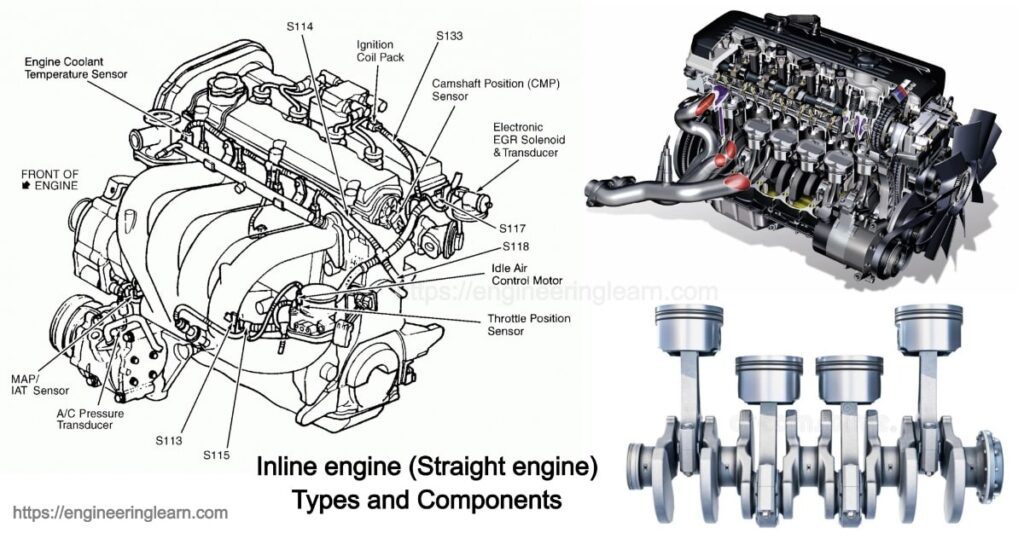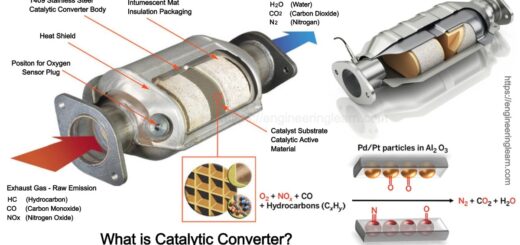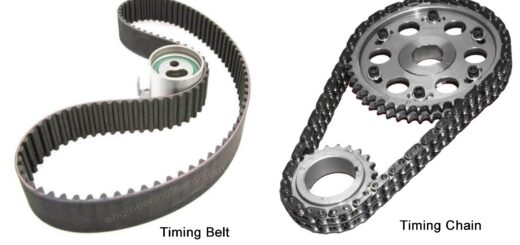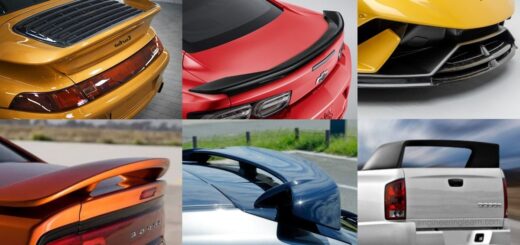Inline Engine (Straight Engine) – Introduction, Uses, Types and Components [Complete Details]

What is Inline Engine (Straight Engine)
Inline Engine Types and Components :- The inline engine are also named as straight engine which is an internal combustion engine with all the cylinders aligned in a single row having no offset. These engines are commonly found in four, six and eight cylinder configurations which have been used in popularly in automobiles, locomotives and aircraft whereas the term in-line has a wider meaning when it is applied to the engine of the aircraft. ( Types of Engines )
A straight or inline engine is considerably quite easier to construct as compared to any other equivalent horizontally opposed or V engine as both of the cylinder bank and the crankshaft can be milled from a single metal casting which is required for fewer cylinder heads and camshafts. In-line engines are usually smaller than the overall physical dimensions and designs like the radial can be mounted in various directions. Straight configurations are quite simpler as compared to the V-shaped counterparts.
As by now it is known that the straight engines are also called inline engines which have all cylinders that are aligned in one row along with the crankshaft with no offset. When a straight engine is mounted at a particular angle it is referred to as a slant engine.
Types of Inline Engines
There are various types of straight engines which are as follows:
• straight-2 or Parallel Twin
• straight-3 or Inline Triple
• straight-4
• straight-5
• straight-6
• straight-8
• straight-10
• straight-12
• straight-14
The inline-four engines are the most popular four-cylinder configuration, although the straight-6 has largely given way to the V6 engine, which does not naturally run in the smaller or both length and height which is easier to fit into the bay of the engine of a comparatively smaller as well as modern cars. There are some manufacturers like Acura, Audi, Ford, Mercedes-Benz, Volkswagen and Volvo who have been consistently using the straight-five configurations whereas the General Motors Atlas family includes a straight-four, straight-five and even straight-six engines wherein some small cars are found having inline three engines.
The straight-eight engine was one of the prestige engine arrangement which could be made cheaply as compared to a V-engine by the makers of the luxury car who would deeply focus on other specifications and also the geometric ones which calls out engines that are more powerful than any V8 engine.
In the mid1930s, Duesenberg used a cylinder block which was made from aluminum alloy comprising four valves per cylinder, hemispherical heads which intended to produce the most powerful engine of the market. This was the best selling point for Pontiac which introduced the cheapest straight-eight in the year 1933. Whereas, the following World War II was supplanted by the lighter as well as more compact V8 engines that allowed only shorter engine bays which were used in its designing.
How to Locate Straight Engine?
Considering a case wherein when a straight engine is mounted at a vertical angle is termed as a slant engine, which was used by Chrysler’s Slant 6 in many models in the 1960s and 1970s. After thus Honda was also found mounting its straight-four and straight-five engines at a slant. SAAB was initially used in the Triumph Slant-4 engine which were tilted specifically at an angle of 45 degrees after which the later versions of the engine were less tilted.
There are two main factors which have led to the recent decline of the straight-six engines in the application of automotive. The first reason was the balance shafts of Lanchester which was reintroduced by Mitsubishi in the 1980s in order to overcome the natural imbalance of the inline-four engine which was rapidly adopted by various other manufacturers and also made both inline-four and V6 engines for smoother-running and even greater smoothness of the straight-six layout is no longer an advantage.
The second reason was the fuel consumption which became more important, as the cars became smaller and even more space-efficient. Although, the engine bay of a modern small or a medium car is designed typically for an inline-four which oftenly does not have any room for a straight-six whereas can fit a V6 with only slight modifications.
Vision of Manufacturers
Some manufacturers which were originally from Lancia or more recently Volkswagen with the VR6 engine had made an attempt to join the advantages of a straight and V configurations by producing developing a narrow-angle V. This was a comparatively more compact configuration than either of the configurations, but is compared to be less smooth than any other.
In the strict sense, there were many straight engines which had been produced specifically for the aircrafts, that too from many years of aviation and via interwar period that leaded up to the second world war. The straight engines were quite simpler which also had low frontal area, reduced drag and also provided better cockpit visibility.
The well-known Gipsy family of engines and their descendants included straight-four and straight-six upright and inverted air-cooled engines which were used through a very wide range of smaller aircraft all around the world that included the Tiger Moth biplane, and also helped in making the configuration popular specifically for light aircraft.
Design of Straight-Four Engine
A four-stroke straight-four engine is always found having a cylinder on its power stroke, unlike other engines there are fewer cylinders which had no power stroke which occurred at the certain times. As compared to the V4 engine or a flat-four engine, a straight-four engine has only one cylinder head, which is found reducing the complexity of the engine and also its production cost.
Whenever a straight-four engine is installed at an inclined angle, it is referred to as slant-four engine.
The Dry-Sump Principle
The dry-sump lubrication system is a system in which the entire oil supply is retained in an external reservoir and not in the oil sump. The oil pump is of three stage design. Two stages help in drawing the oil out from the oil sump at various points and pumps it into the reservoir. Whereas the third stage which is known as the discharge stage returns the oil from the reservoir to the engine with the help of an oil cooler or oil filter. The oil sump can also be kept small and flat due to its lower oil volume intending to result that the engine has a smaller overall height. This requires a comparatively more complex design.
Displacement of Straight Engine
The displacement of a petrol straight-four engines used in modern production cars typically varies from 1.3–2.5 L, whereas the larger engines have been used in the past, for instance, the Bentley 4½ Litre in the years 1927-1931.
The displacements produced by Diesel engines was quite larger such as a 3.2 L turbocharged Mitsubishi engine which was mostly used in Pajero, Shogun, Montero SUV and a 3.0 L Toyota engine. The trucks approximately weighed ranging 7.5 to 18 tonnes with a gross vehicle that uses only inline four-cylinder diesel engines with a displacement of approximately 5 litres. Whereas the larger displacements are mostly found in locomotive, marine and stationary engines only.
Displacement need not necessarily be large, it can also be very small, as found in small cars which are sold in Japan. There are several engines which had four cylinders at a time when the regulations dictated a maximum displacement of 550 cc and a maximum size in today’s time is 660 cc.
Primary and Secondary Balance
The Straight-four engines comprise of the preferred crankshaft configuration which have a perfect primary balance. This is as the pistons continuously move in pairs wherein one pair of piston always moves up at the same time as the other pair moves down.
The straight-four engines have a secondary imbalance which is caused by the acceleration or deceleration of the pistons which is done during the top half of the crankshaft rotation being greater than that of the pistons in the bottom half of the crankshaft rotation This resulted in two pistons being always accelerating faster in one direction, whereas the other two accelerating slowly in the other direction, which particularly lead to a secondary dynamic imbalance that caused an up- down vibration at twice the speed of a crankshaft. This imbalance is found popularly amongst all the piston engines which effects the strong inline-four as the two pistons keep moving together always.
Pulsations in Power Delivery
There are four-stroke engines with five or more than five cylinders which are able to have at least one cylinder that performs its power stroke at a given point of time. Whereas, the four-cylinder engines have gaps in the power delivery, as each and every cylinder completes its power stroke before the next piston gets started a new power stroke. The pulsating delivery of power leads to higher vibrations than engines with more than four cylinders.
Usage of Balance Shafts
A balance shaft system is mostly used to reduce the number of vibrations which are created by a straight-four engine. These are found most often in engines which make larger displacements. The invention of balance shaft system was done in the year 1911 which consisted of two shafts that carried an identical eccentric weights which rotated in opposite directions at twice the speed of a crankshaft. This system was brought into being by the Mitsubishi Motors in the early 1970s and since then had been used under the licence by several other companies.
The relatively large engines are the one which comprises of a balance shaft and also includes the 2.4 litre Citroën DS engine. These engines displace up to 2.9 litres which was produced without the balance shafts from the early 1950s to the late 1990s. Thus, these are relatively low-revving engines which decrease the need of a balance shaft system.
Straight Engine usage in Production Cars
Most of the modern straight-four engines are used in cars which have a displacement varying from 1.5–2.5 L. The automotive straight-four engine was the one which was used from the year 1963–1967 had a displacement of around 356 cc whereas the largest mass-produced straight-four car engine by the years 1999–2019,where the Mitsubishi 4M41 diesel engine was used in the well-known car Pajero and was found having a displacement of 3.2 L. Some straight-four car engines include:
- Alfa Romeo Twin Cam engine was from the year 1954–1994 and was amongst the first mass-produced twin-cam engines which in the year 1990 became the first production engine with variable valve timing.
- Ford Model T engine was from the year 1908–1941 and was one of the most widely produced engines in the world.
- BMC was a series engine which was from the year 1951–2000 and was the first engine to be used in a mass-production transverse-engine front-wheel drive car.
- Fiat Twin Cam engine was from the year 1966–2000 and was one of the first mass-produced twin-cam engines which started its production since 1959.
- Triumph Slant-4 engine was from the year 1968–1981 and was an early multi-valve engine which was formed from the basis of first turbocharged engines.
- Honda F20C engine were produced from the year 2000–2009 and was found highest with specific output for a naturally aspirated engine of its time.
Straight Engine usage in Racing Cars
There are numerous cars that comprise of a straight-four engine, these are mostly racing cars, whereas the Peugeot engine won the 1913 Indianapolis and was known to be a highly influential engine which was designed by Ernest Henry. The engine specifically had a double overhead camshafts (DOHC) with particularly four valves per cylinder and a layout that which would become the standard till today for the racing inline-four engines.
Amongst all the engines, an inspiration was the Peugeot design which was the Miller engine that was a successful racing engine throughout the 1920s and early 1930s. This engine eventually evolved into an Offen hauser engine which had a large successful span from the year 1933 until 1981 which included five straight victories at the Indianapolis 500 from the year 1971 to 1976.
There were numerous cars which were produced for the Grand Prix motor racing category which comprised of used inline-four engine designs. Another engine that plays a vital role in the history of racing is the straight-four engine which was designed by Aurelio Lampredi and is used in Ferrari. This engine was basically designed as a 2 L engine specifically for the Ferrari 500, but then it evolved to 2.5 L to compete the Ferrari 625. After this the capacity for sports racing cars was increased up to 3.4 L for the Ferrari 860 Monza.
Components of Straight Four Engine
The straight-four engine were also quite successful racing engine that began their life as a 1.5 litre engine and later on enlarged to 2.0 litres in the year 1958 which was found in the large 2,495 cc and did also won the championship in Cooper’s chassis in the year 1959 and 1960.
The year after 1980s were mostly dominated by the 1,500 cc turbocharged cars. The inline engine was a very notable one from the era of its high boost pressures and performance. The iron block which was casted was based on the standard road car block and powered the cars of Brabham, Arrows and Benetton which also won the world championship in the year 1983. The version of this engine was said to produce about 1,300 hp in qualifying trim which was brought into being in the year 1986.
The cylinders which are opening with a circular cross section extend via upper portion of the block, with bored interior walls and polished to form smooth and accurate bearing surfaces. The cylinders of heavy-duty engines are kept with the removable liners which is made of metal and is more wear-resistant as compared to the block casting.
Most commonly there are two arrangements of cylinders in which the automotive is used vertically, or in-line, type and the V type. The in-line engine were found having a single row of cylinders which extended vertically upwards from the crankcase and aligned with the main bearings of the crankshaft.
The V type engine comprises of two rows of cylinders that usually form an angle of 60° or 90° between the two banks. V-8 engines comprise of eight cylinders which are usually set at an angle 90°. However, there are some small six-cylinder aviation engines which have horizontally opposed cylinders.
Engine Sealing
Each cylinder heads is mostly sealed off from the valve covers using a rubber gasket from its contact faces in order to stop the intake manifold by an elastomer gasket, by a two-layered gasket of embossed metal, and from the crankcase by a multilayer embossed metal gasket. The gasket within the bearing support and the upper section of the oil sump is designed in a single layer and is embossed with metal gasket. The oil pan upper and lower section of the crankcase section supports are sealed by a liquid gasket.
Liquid Gaskets
The most important application of a liquid gasket sealant is the CNC-controlled which ensures a constant sealant supply. The liquid gasket between the lower timing case cover and the upper timing case cover is decided according to the various principles. In this type of case the parts are initially bolted and then the sealant gets injected inside the groove in the upper timing case cover through the zerk-type fitting.
Once the enough liquid sealant has been injected all the remaining sealant is discharged from the openings on the end of the timing case cover. Whereas it has to be replaced while repairing the gasket.
The pump of the coolant is placed inside the cylinder block at the face end and is mounted directly upstream on the duct of the central coolant which is driven by the ribbed V-belt. Electronically Controlled Engine Cooling uses the small cooling circuit to the large cooling circuit which is controlled by an electrically actuated Map Controlled Engine Cooling Thermostat.
In order to replace this valve, it is necessary to remove the intake manifold by heating the wax electrically or thermocouple in the Map Cooling Thermostat which is possible to control the switching point and the coolant temperature. It makes it possible for the engine to reach the required temperature in accordance with the requirement of the engine’s operations.
Air Supply
The air that is supplied is supplied through a tapered intake pipe. This is a four-part design which is made of an aluminium alloy. The lower section of an intake manifold is bolted to the cylinder head within the two cylinder banks. The upper section of the larger intake manifold is mounted to the lower section. The upper section of the intake manifold is designed in such a way that the manifolds for different banks can be removed separately. This made it easier to gain access within the individual ignition coils and spark plugs, for instance in an inline engine, the supply of air for both manifolds is guided.
The oil sump is the one which comprises of two aluminum parts which are die casted. The oil sump of the lower section forms an oil reservoir whereas the central oil passage is located inside the upper section of the oil sump. There are special baffles which settles the oil in the oil sump. The Level of the engine oil informs the Motronic Engine Control Module of the oil level which is inserted into the lower section of the oil sump from below close to the oil drain screw after which it is bolted into place.
Engine Detailing
The engines like inline engine consist of a wet-sump lubrication system and a dry-sump lubrication system specifically in Audi cars, wherein the entire oil supply is retained in the oil sump. The single-stage of oil pump draws the oil out from the wet sump through the intake line and then immediately returns it to the engine after it has been cooled down and has been filtered. In reference to the dry-sump the work of the oil sump with the wet sump is to retain the supply of the entire oil which results in a larger volume and also affects the overall height of the engine.













